Where will our children and grandchildren live?
March 29, 2017
OPINION by MICHAEL F BROWN
Long-term Santa Barbara County homebuilder and philanthropist Mike Towbes has wryly pointed out that opposition to development of new housing is usually based either on dislike of urban sprawl or on dislike of density. Taken to their logical extremes, and if bans on both are incorporated into local land use polices occur simultaneously, not much can ever be built.
Ironically and disingenuously, San Luis Obispo County’s overall no-sprawl scheme of land use, so-called “smart growth” plan, mandates that new homes be largely developed in the county’s seven incorporated cities (over which the county board has no land use authority).
As a sop to the idea of building homes, previous SLO County Board of Supervisors majorities gave lip service to new development but required that it be restricted to the four village areas of Nipomo, Oceano, Templeton, and San Miguel. A subsequent County study indicated that an investment of $400 million in roads, utilities, drainage, and other public facilities would be required to allow development in the four villages.
The underlying theory is that sprawl is inefficient from the standpoint of providing municipal services, is unsightly and harmful to natural resources, and, most importantly, generates too much climate changing greenhouse gas because of all the driving that low density development promotes.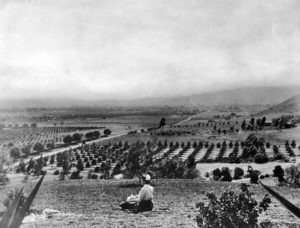
For the past six decades, urban sprawl has been opposed by academics, city and regional planners, environmentalists, public officials, media, and the rest of the “intelligentsia,” most of whose members are already both smugly and snugly housed in affluent sprawl communities.
Along these lines, Los Angeles is often demonized as the poster child for bad sprawl development. The photo to the right shows Hollywood in 1905 and the road that ultimately became the legendary Sunset Boulevard. The view is toward the west and what would eventually become Beverly Hills, Bel Air, and Brentwood. Perhaps the view reached all the way to the Pacific on a clear day.
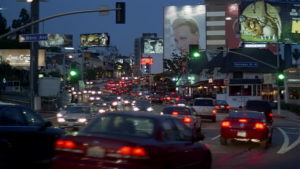 The nostalgic scene, evocative of the plein air paintings of the era, has evolved over the last 112 years into an intense commercial strip surrounded by some of the most fantastically expensive sprawl housing on the planet. The photo above displays today’s Boulevard’s almost dystopian aspect, especially when viewed in the historical context. This is the “bad” LA, which we have been conditioned to revile. Note that the folks don’t seem to be abandoning their cars in droves.
The nostalgic scene, evocative of the plein air paintings of the era, has evolved over the last 112 years into an intense commercial strip surrounded by some of the most fantastically expensive sprawl housing on the planet. The photo above displays today’s Boulevard’s almost dystopian aspect, especially when viewed in the historical context. This is the “bad” LA, which we have been conditioned to revile. Note that the folks don’t seem to be abandoning their cars in droves.
The 1922 photo below, to the left, depicts what was to become the intersection of Santa Monica Boulevard (the storied US Route 66) and Westwood Boulevard. The open space seems to stretch to the horizon. Here three obviously enthusiastic and, as it turned out, prophetic developers are plotting the “sprawful” future.
The contemporary photo to the right above is of Westwood Boulevard (the future boulevard promised on the sign), just to the south of the area in the historical picture.
The aerial photo below looks west from Century City to Santa Monica and Pacific Palisades. The corridor in the upper right quadrant of picture, which is lined by a string of high-rise apartments and condos, is Wilshire Boulevard. Some of the most expensive real estate and highest rents in the United States are characteristic of properties in this picture.
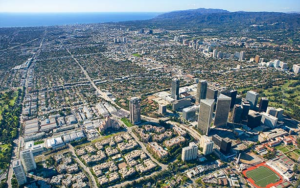 Notwithstanding the apparent aversion to sprawl, many hundreds of thousands of people are living very well within the area depicted in the photo.
Notwithstanding the apparent aversion to sprawl, many hundreds of thousands of people are living very well within the area depicted in the photo.
Many would not consider living anywhere else. Many are highly educated and successful. Most actually do not live in high rises. What is actually going on that allows people to live here, raise children, and actually enjoy life?
The fact is that the sprawl of the 1920’s, 30’s, and 40’s, which led to today’s urban spatial pattern, has been highly successful. It has provided successive generations of residents with homes and, in many cases, well paying jobs, business ownership, educational choice, and huge upward mobility. Millions of people have inter-generationally passed through the accumulated “sprawl” housing stock between the 1920’s and the present day — almost 100 years.
The secret that the anti-sprawl elitists don’t want you to know is that most of the homes in the area are still single-family houses with a front yard, backyard, side yards and quiet privacy. The apartments and condos, and especially the high-rises (and traffic), are located on the ends of the blocks on collector and arterial streets. The long sides of the blocks are largely quiet residential streets with single-family homes that were built in the 20’s and 30’s (some more recently in Brentwood and Pacific Palisades in the 50’s and 60’s).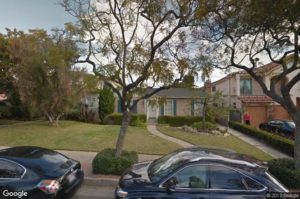
A typical quaint home of the era is shown in the recent photo to the right. It was built in 1938 for $12,000 and has 2 baths, three bedrooms, a dining room, a fire placed living room, and hardwood floors. It has a backyard with a patio, lawn area, fruit trees, and a two-car garage with access from the alley.
The street is lined with flowering trees. It is walking distance to an elementary school and biking distance to a junior high, a small but ample and unique commercial area, and the beach. It is served by frequent bus service on an arterial about half a block away. Within a 30-minute drive are UCLA, several world-class art museums, LAX, and some of the most diverse and eclectic shopping on the planet.
The home was part of the massive sprawl development of the 20’s and 30’s that took place on the west side of the LA area. The density and amenities are features that the proponents of “smart growth” say they support. But if today’s state and local land use laws had existed back then, it could never have been built. The land had been part of an orchard.
The dramatic sprawl shown in the aerials (remember this was all dirt fields as illustrated in the 1922 photo above) is regarded as negative, but what about the actual ground level reality? The fact is that the LA metro area (not just the city) is composed of hundreds of nodes with similar homes (often with very different styles) and served by nearby shopping and public services.
Today, many have very distinctive cultural heritages and characteristics that enrich everyone’s experience and choices. Still, the key feature is the single-family home with a yard and garage.
This is a tragedy because the state and local land use laws have become so draconian and destructive, and both permitting fees and development taxes are so confiscatory, that the history of the 20’s, 30’s, 40’s, 50’s, and 60’s cannot be transposed or recreated elsewhere. As a result of the government-imposed scarcity, Zillow shows the home pictured above as having sold for $2.2 million a few years ago and estimates its current sales price to be $2.7 million.
One question is: Where are millions of immigrants who have come to California in recent decades to live? Another is how do we replicate the fantastic opportunities which early and mid-twentieth century sprawl conferred on tens of millions of families?
Do we deny the same opportunity to the new immigrants, which so many elected officials say must be protected and defended from deportation? Or do we simply make LA and Oakland denser with massive Soviet era prison-style concrete apartment blocks?
On a much smaller and more manageable scale, the question in SLO County is more related to where will our children and grandchildren be able to live? Will they have to move to Austin and Reno to have a home? And where will employees required by San Luis Obispo County businesses, educational institutions, and health care providers be able to live?
As a recent popular song about success, love, and young people struggling in LA asks, “City of Stars, will you shine for me?”
How about for our children and grandchildren?
Mike Brown is the Government Affairs Director of the Coalition of Labor Agriculture and Business (COLAB) of San Luis Obispo County. He had a 42-year career as a city manager and county executive officer in four states including California. He can be reached at mike@colabslo.org.


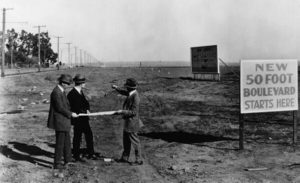
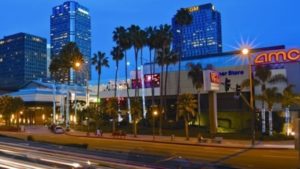






The comments below represent the opinion of the writer and do not represent the views or policies of CalCoastNews.com. Please address the Policies, events and arguments, not the person. Constructive debate is good; mockery, taunting, and name calling is not. Comment Guidelines